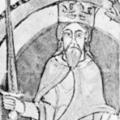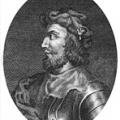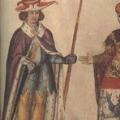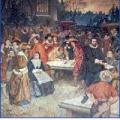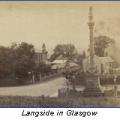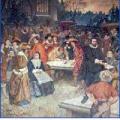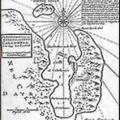Categories
Most Liked
Posted on July 17, 2013
by Amanda Moffet
by Amanda Moffet
Posted on May 12, 2013
by Chas Mac Donald
by Chas Mac Donald
Posted on August 29, 2013
by Amanda Moffet
by Amanda Moffet
Posted on February 7, 2013 by Donald | 1 views | comments
Malcolm IV (or Máel Coluim mac Eanric), King of Scots, was the eldest son of Earl Henry (d. 1152) and Ada de Warenne. The original Malcolm Canmore, a name now associated with his great-grandfather Máel Coluim mac Donnchada, he succeeded his grandfather David I, and shared David's Anglo-Norman tast...
Posted on February 7, 2013 by Donald | 1 views | comments
King David I (or Dabíd mac Maíl Choluim; also known as Saint David I or David I "the Saint") was King of Scotland from 1124 until his death, and the youngest son of Malcolm Canmore and of Saint Margaret (sister of Edgar Ætheling). He married Matilda, daughter and heiress of Waltheof, Earl of Nort...
Posted on February 7, 2013 by Donald | 1 views | comments
Alexander I of Scotland or Alaxandair mac Maíl Coluim was the fourth son of Máel Coluim mac Donnchada by his wife Margaret, grand-niece of Edward the Confessor. He was named in honour of Pope Alexander II.
Alexander was his unmarried brother Edgar's heir, perhaps throughout his reign. On the deat...
Posted on February 7, 2013 by Donald | 1 views | comments
Máel Coluim mac Donnchada (Malcolm III) was King of Scots. He was the eldest son of Donnchad mac Crínáin. While often known as Malcolm Canmore, the earliest epithet applied to him is Long-Neck. It appears that the real Malcolm Canmore was this Máel Coluim's great-grandson Malcolm IV.
Máel Coluim'...
Posted on February 7, 2013 by Donald | 1 views | comments
Donnchad mac Crínáin (Duncan) was king of Alba. He was son of Crínán, hereditary lay abbot of Dunkeld, and Bethóc, daughter of king Máel Coluim mac Cináeda.
Unlike the "King Duncan" of Shakespeare's Macbeth, the historical Donnchad appears to have been a young man. He followed his grandfather Máe...
Posted on February 7, 2013 by Donald | 1 views | comments
John, King of Scots is usually known as John Balliol or, correctly, John de Balliol. He was born in 1248, the son of Dervorguilla of Galloway and John, 5th Baron de Balliol, Lord of Barnard Castle and founder of Balliol College in the University of Oxford, one of the first colleges founded in Oxfo...
Posted on September 10, 2024 by Langstyn | 1 views | comments
Oregon State vs. Washington StateWallis Beasley Doing Arts Coliseum, Pullman, Washington; Wednesday, 10 p.m. ESTBOTTOM LINE: Oregon State searches for its fifth straight meeting win versus Washington State. Oregon State's last Pac-12 loss came versus the Oregon Ducks 69-54 on Feb. 27. Washington Sta...
Posted on September 10, 2024 by Langstyn | 1 views | comments
By RJ Youthful and Michael CohenFOX Sports University Football WritersIowa brings its vaunted protection right into Columbus on Saturday and will certainly attempt to reduce C.J. Stroud and the dynamic offense of the No. 2 Ohio State match will serve to begin Week 8 of the university football weeke...
Posted on February 6, 2013 by Donald | 0 views | comments
Continuing from his success against the English at the Battle of Stirling Bridge in 1297, William Wallace had continued his ‘liberation of Scotland’ with the recapture of Berwick and raids across Northumberland. In the name of the absent John Balliol he was made a Guardian of the Realm in the March ...
Posted on February 6, 2013 by Donald | 0 views | comments
In 1332 during an Anglo-Scots peace, Edward Balliol sailed with eighty-eight ships from the Humber to Fife and fought his way to Scone. His father John had abdicated in 1296 and Edward, claiming his family as still the true royal line, had himself crowned King of Scotland.
David II’s claim had the ...
Posted on February 6, 2013 by Donald | 0 views | comments
St Andrews University is first mentioned in documents of 1410, but its birth is usually assigned to the charter given to Bishop Henry Wardlaw in 1412, endorsed the following year by Pope Benedict XIII.
This was Scotland’s first university and had Warlaw as its Chancellor, while Laurence of Lindores ...
Posted on February 6, 2013 by Donald | 0 views | comments
A covenant is a contract between God and the people.
In 1557 a group of Protestant nobles opposed to Mary marrying the Roman Catholic Dauphin of France, signed a covenant to state that they would promote the ‘blessed work of God and his Congregation against the Congregation of Satan’, the former...
Posted on February 6, 2013 by Donald | 0 views | comments
The most influential person of the Scottish Reformation, John Knox, was first ordained as a Catholic priest.
Knox spent time in the company of George Wishart before he was arrested and burned for heresy in March 1546 by Cardinal Beaton. Knox joined the Reformers, who murdered Cardinal Beaton the...
Posted on February 6, 2013 by Donald | 0 views | comments
Queen Mary’s reign was in tatters when she escaped from Loch Leven Castle on 2 May 1568. A week later she had gathered six thousand men willing to fight for her as she headed for the safety of her strong Dumbarton Castle, which Lord Fleming was holding for her.
Lord James Stewart, her half-brothe...
Posted on February 6, 2013 by Donald | 0 views | comments
Charles I’s views of himself, theology and politics became increasingly contradictory to the beliefs of the Presbyterians. Charles tried to bring together the laws and churches of Scotland and England, with all roads leading to himself.
In 1637 he produced the Book of Common Prayer, written witho...
Posted on February 6, 2013 by Donald | 0 views | comments
James Graham, 5th Earl and later 1st Marquis of Montrose, was born in 1612 and studied at St Andrew’s University.
In 1638 he contributed to the National Covenant, and fought for the Covenant in the Bishops’ Wars. As the country moved into ever more turbulent times, Montrose’s sympathies moved bac...
Posted on February 6, 2013 by Donald | 0 views | comments
Under James Graham, the Marquis of Montrose, the Royalist army had achieved success at Inverlochy and Dundee.
He made camp with his 1750 men and 250 horses at Auldearn, around three miles to the east of Nairn. The Covenanters were marching through the night from Inverness to fight him.
Sir John ...
Posted on February 6, 2013 by Donald | 0 views | comments
Civil War had begun in earnest by 1642. Charles I was the enemy of the Presbyterians in Scotland and the parliamentarians in England.
His lack of ability at negotiation and conciliation had compounded his situation. Montrose had done well for him in undermining the Calvinists and Campbells for a ...
Posted on February 6, 2013 by Donald | 0 views | comments
Following success against the military at the recent Battle of Drumclog, the Conventiclers’ support had swollen to six thousand when they came together at Hamilton in June 1679.
Differences between Covenanters which had undermined them through the 1650s, again created factions among their numbers...
Posted on February 6, 2013 by Donald | 0 views | comments
James had converted from Protestantism to Catholicism in 1668 whilst his brother Charles II was monarch. When the King too converted and tried to re-install Catholicism among his subjects around 1672, there was outrage. Acts were passed in Parliament, such as the Test Act, so only Anglicans could ...
Posted on February 6, 2013 by Donald | 0 views | comments
For twenty years the London East India Company had enjoyed soaring success, bringing incredible fortunes to its stockholders through its virtual monopoly of Eastern trade.
By 1695 competitors in the market were using every scandalous technique to have Bills in their favour passed in England’s Par...
Featured Articles
Most Discussed
Posted on July 16, 2013
by Amanda Moffet
by Amanda Moffet
Posted on February 6, 2013
by Donald
by Donald
Posted on July 17, 2013
by Amanda Moffet
by Amanda Moffet


 View More
View More View Less
View Less
